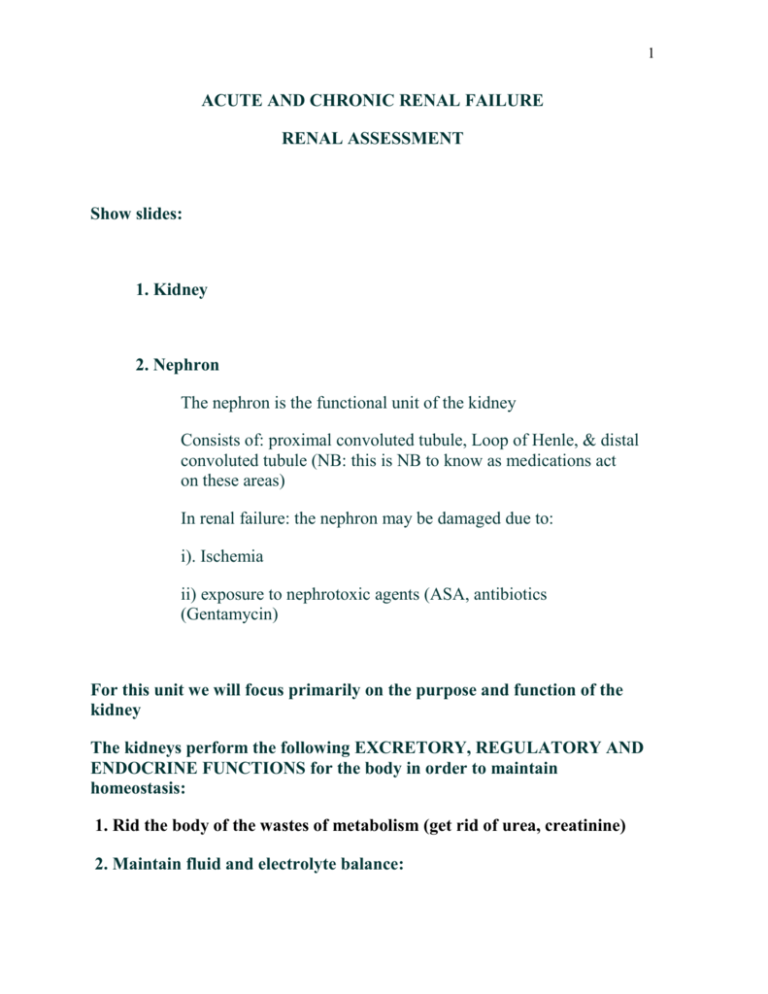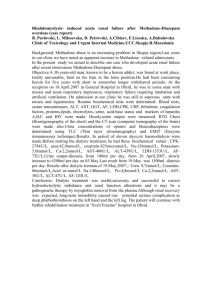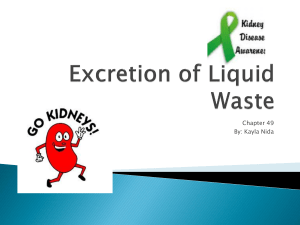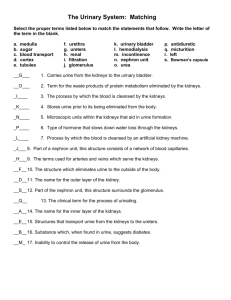Renal Assessment
advertisement

1 ACUTE AND CHRONIC RENAL FAILURE RENAL ASSESSMENT Show slides: 1. Kidney 2. Nephron The nephron is the functional unit of the kidney Consists of: proximal convoluted tubule, Loop of Henle, & distal convoluted tubule (NB: this is NB to know as medications act on these areas) In renal failure: the nephron may be damaged due to: i). Ischemia ii) exposure to nephrotoxic agents (ASA, antibiotics (Gentamycin) For this unit we will focus primarily on the purpose and function of the kidney The kidneys perform the following EXCRETORY, REGULATORY AND ENDOCRINE FUNCTIONS for the body in order to maintain homeostasis: 1. Rid the body of the wastes of metabolism (get rid of urea, creatinine) 2. Maintain fluid and electrolyte balance: 2 1. RE FLUID BALANCE: The kidney: - regulates urine output; responds to hypervolemia (by ↑ urine output: we see dilute urine); - responds to hypovolemia (by ↓ urine output & concentrates urine) - when there is damage, polyuria, oliguria, and anuria can result 2. RE ELECTROLYTE BALANCE: The kidney responds to changes in electrolyte balance such as: Hyperkalemia, Hypocalcemia, Hyperphosphatemia, Magnesemia, Hyper and hyponatremia 3. ACTIVATES VITAMIN D: Converts Vit D to its active metaboltye in order to facilitate absorption of calcium from the GI tract so that the Calcium/phosphate ratio may remain in balance 4. ACID-BASE BALANCE: 5. CONTROL BLOOD PRESSURE: 6. STIMULATE RBC PRODUCTION & PROLONG RBC LIFE: 3 Assessment of Renal Function: Assessment of renal function may be based upon blood composition, urine composition tests, and renal clearance tests. Blood Tests • Blood tests of renal function include tests for plasma creatinine levels (44 – 133 μmol/Litre) Blood test for blood urea nitrogen, BUN levels (1.8 – 7.1 mmol/Litre) Although the BUN test is widely used for screening renal malfunction, the plasma creatinine is a more reliable indicator of renal function. Urinalysis Urinalysis considers physical examination, chemical examination, microscopic examination and bacteriological examination of urine: • PHYSICAL EXAMINATIONS consider total urine volume and specific gravity 1.016 – 1.022 An increase in urine volume is called polyuria and is an indication of the tubule's inability to reabsorb water. The specific gravity is an indicator of how well the kidneys are concentrating urine CHEMICAL EXAMINATIONS consider the protein levels in urine. Increases are called proteinuria, and because most of these are albumins, we also call it albuminuria. In glomerulonephritis, the albumins originate in the blood; in pyelonephritis, the proteins originate in the urinary tract walls. MICROSCOPIC EXAMINATIONS consider the number and type of particles in urine. These include crystalloid matter, erythrocytes, leukocytes, and casts. Casts form within tubules when protein is present and may contain erythrocytes or leukocytes or both. BACTERIOLOGICAL EXAMINATIONS consider the presence, number and kind of bacteria in urine. 4 Urine Creatinine: 124 -230 μmol/kg/day Clearance Tests Clearance tests help determine how efficiently the kidneys process the blood delivered to it; It compares the amount of a substance in blood with the amount of the same substance in urine. Time may or may not be a factor. The amount of substance in plasma, in urine, and urinary output rate (also a factor that considers body surface area) are determined. Reports indicate the amount of substance cleared per volume of blood or a volume of blood cleared of a substance per unit time. 24 hour Creatine clearance test reflects glomerular filtration rate because none is reabsorbed by the renal tubule system. • Normal = 1.5 – 2.3 mL/sec How Done? Have patient urinate at the beginning of the day. Discard specimen. Collect the urine output for the next 24 hours. 5 Assessment of the Urinary System • Subjective Data Important Health Information • Past health history • Medications • Surgery or other treatments Functional Health Patterns • • • • • • • • • • • Health perception – health management Nutritional – metabolic Elimination Activity – exercise Sleep – rest Cognitive – perceptual Self-perception – self-concept Role – relationship Sexuality – reproductive Coping – stress tolerance Value – belief • Objective Data Physical Examination • • • • Inspection Palpation Percussion Auscultation 6 Inspection: assess for changes in the following: Skin: pallor, yellow-grey cast, excoriation, changes in turgor Mouth: ammonia breath odour Face & extremities: generalized edema, peripheral edema, bladder distension, enlarged kidneys Abdomen: stria, abdominal contour changes Weight: weight gain d/t edema; weight loss and muscle wasting in renal failure General health status: fatigue, lethargy, diminished alertness Palpation: Palpate the kidneys just below the back parts of the rib cage (see Health Assessment text!) Percussion: Assess tenderness in the flank area: normally this does not elicit pain Auscultation: Assess for bruit over the costovertebral angle that is formed by the rib cage and the vertebral column (front of body); If hear a bruit (abnormal murmur), this indicates impaired blood flow to kidneys 7









